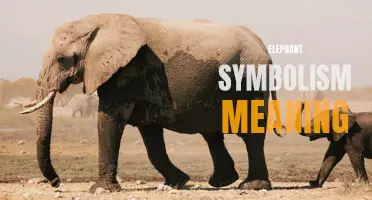
Rabbits have long been associated with various symbolic meanings across cultures and time periods. In many instances, they represent fertility and rebirth, due to their prolific breeding capabilities and the idea that they give birth to large litters. Rabbits are also often associated with speed and agility, due to their ability to quickly evade predators. Additionally, rabbits are often seen as cunning and adaptable animals, able to survive in a variety of environments. These symbolic meanings make rabbits a fascinating and rich subject of study in folklore, mythology, and literature.
What You'll Learn
- What is the symbolic meaning of rabbits in different cultures and traditions?
- How do rabbits symbolize fertility and rebirth?
- What role does the rabbit play in mythology and folklore?
- How does the rabbit symbolize agility and quickness in various contexts?
- In what ways do rabbits represent innocence and vulnerability?

What is the symbolic meaning of rabbits in different cultures and traditions?
Rabbits have been a symbol of fertility, abundance, and rebirth in various cultures and traditions around the world for centuries. These furry creatures have captured the imaginations of people and have been featured in folklore, mythology, and even religious beliefs. Let's take a closer look at the symbolic meaning of rabbits in different cultures.
In many European cultures, rabbits are associated with the arrival of spring and new life. This connection stems from their prolific breeding habits and their ability to reproduce quickly. Rabbits are often used as symbols of fertility in various rituals and festivals during the spring season, such as Easter. In fact, the Easter Bunny, a popular symbol in Western countries, is said to bring eggs and gifts to children on Easter Sunday.
In Chinese folklore, rabbits are associated with the moon. According to the legend, a rabbit resides on the moon and pounds a medicine called the elixir of immortality with a mortar and pestle. The moon rabbit is regarded as a symbol of longevity, and its image can be seen in traditional paintings and sculptures. In addition, the Chinese zodiac includes the Year of the Rabbit, which is believed to bring good luck and fortune to those born under its influence.
In Native American cultures, rabbits are often seen as tricksters and bringers of change. Some tribes believe that rabbits possess magical powers and are capable of shape-shifting, bringing luck and fortune to those who encounter them. Rabbits are also associated with speed and agility, qualities that are valued in hunting and survival.
In Japanese folklore, rabbits are known for their association with the Buddhist deity, Monjushiri. Monjushiri is often depicted with a rabbit as his sacred animal, symbolizing wisdom and intelligence. The rabbit is also believed to possess the ability to perceive the unseen, making it a powerful symbol in Japanese mythology.
In African folklore, rabbits are often portrayed as clever and cunning animals. They are known for their ability to outsmart predators and survive in challenging environments. In some stories, rabbits are depicted as the heroes who use their intelligence and quick thinking to overcome obstacles and solve problems.
Overall, rabbits hold a prominent place in many cultures and traditions around the world. Their symbolism varies from fertility and abundance to intelligence and agility. Whether it's the Easter Bunny or the moon rabbit, these furry creatures continue to captivate the human imagination and remind us of the cycles of life, rebirth, and the inherent connection between nature and humanity.
Understanding the Meaning Behind Dehumidifier Symbols: A Handy Guide
You may want to see also

How do rabbits symbolize fertility and rebirth?
Rabbits have long been associated with fertility and rebirth in various cultures and belief systems around the world. This symbolism can be traced back to ancient times and is still seen in many traditions today. The connection between rabbits and fertility can be attributed to several factors.
One of the main reasons why rabbits symbolize fertility is their ability to reproduce rapidly and in large numbers. Rabbits are known for their high fertility rates and short gestation periods. A female rabbit, also known as a doe, can become pregnant shortly after giving birth and can have multiple litters in a year. This prolific reproductive capacity of rabbits has led them to be seen as a symbol of abundance and fertility.
Furthermore, rabbits are commonly associated with spring, a season that symbolizes renewal and rebirth. In many cultures, spring is seen as a time of growth and new beginnings, and rabbits are often seen as a representation of this constant cycle of life. The arrival of spring is often marked by the sight of rabbits hopping around, as they emerge from their burrows after the long winter hibernation. This association between rabbits and the rejuvenation of nature has led to their symbolism of rebirth.
In addition to their reproductive capabilities and association with spring, rabbits are also often depicted as playful and joyful creatures. Their energetic behavior and cute appearance have made them popular symbols of joy, happiness, and youthful vitality. Rabbits are often portrayed alongside eggs during Easter celebrations, which further reinforces the connection between rabbits and rebirth.
Rabbits' symbolism of fertility and rebirth is observed in various cultural and religious traditions. In ancient Egypt, the goddess of fertility, Hathor, was often depicted with the head of a rabbit. In Chinese culture, the rabbit is one of the twelve animals of the Chinese zodiac and is associated with luck, abundance, and fertility. In some Native American tribes, the rabbit is seen as a symbol of life and creation.
The rabbit's symbolism of fertility and rebirth has also been adopted by Christianity. The Easter Bunny, a popular figure associated with Easter celebrations, is said to bring eggs and gifts to children. The Easter Bunny's role in delivering eggs is believed to symbolize new life and rebirth, while the eggs themselves represent fertility.
In conclusion, rabbits have long been associated with fertility and rebirth due to their ability to reproduce rapidly and their connection to spring. The rabbit's symbolism of abundance, new beginnings, and joy can be seen in various cultures and religious beliefs. Whether it be through ancient mythologies, the Chinese zodiac, or Easter celebrations, rabbits continue to embody the concepts of fertility and rebirth.
Unlocking the Symbolic Meaning of the Nest: What Does It Represent?
You may want to see also

What role does the rabbit play in mythology and folklore?
In mythology and folklore, the rabbit is often portrayed as a clever and mischievous creature, with various roles and meanings across different cultures.
In some Native American tribes, the rabbit is seen as a trickster figure, known for its quick wit and cunning. In many stories, the rabbit outsmarts other animals or even humans, using its intelligence to escape danger or outmaneuver its opponents. The rabbit's cunning and resourcefulness often serve as a lesson for humans, teaching them to use their wits and creativity to navigate through challenges.
In Chinese mythology, the rabbit plays a prominent role in the legend of the Moon Goddess Chang'e. According to the story, the goddess was banished to the moon and transformed into a rabbit as a punishment for stealing the elixir of immortality. The rabbit is believed to be constantly pounding a mortar and pestle, preparing the elixir in the moon palace. The rabbit in this tale is a symbol of sacrifice and devotion, as it gave up its rightful form to help the goddess.
In Japanese folklore, the rabbit is associated with the Moon as well. It is believed that a rabbit can be seen in the Moon's reflection during the harvest moon festival. The image of a rabbit pounding rice cakes on the moon's surface is a well-known motif in Japanese art and literature.
In European folklore, the rabbit is often associated with fertility and abundance due to its reputation for breeding rapidly. The image of the rabbit as a symbol of fertility is particularly prevalent during springtime and Easter celebrations. The tradition of the Easter Bunny, who hides eggs for children to find, is believed to have originated from German folklore, where the "Osterhase" was believed to bring eggs and gifts to well-behaved children.
The rabbit also appears in various other mythologies and cultures around the world. In Aztec mythology, for example, the god Quetzalcoatl is said to have taken the form of a rabbit to represent resurrection and rebirth. In African folklore, the rabbit is often portrayed as a clever trickster as well, using its wits to avoid predators or outsmart other animals.
Overall, the rabbit holds a significant place in mythology and folklore, representing different characteristics and meanings depending on the culture. From its role as a trickster and clever creature to its associations with the Moon and fertility, the rabbit continues to fascinate and inspire stories and symbolism in various traditions.
Understanding Symbolic Speech: What It Is and Why It Matters
You may want to see also

How does the rabbit symbolize agility and quickness in various contexts?
The symbol of the rabbit is often associated with agility and quickness in various contexts. This small creature possesses incredible speed, enabling it to appear almost as a blur as it hops and darts through the grass. In different cultures, the rabbit symbolizes these traits and is often used as a metaphor for quick thinking, swiftness, and the ability to adapt to change.
In many ancient mythologies and folktales, the rabbit is depicted as a cunning and quick-witted creature. In Chinese folklore, for example, the rabbit is one of the twelve animals of the Chinese zodiac and is known for its intelligence and agility. According to legend, the Jade Emperor held a race to determine the order of the zodiac animals, and the rabbit used its speed and cleverness to secure its place in the lunar calendar.
In Native American cultures, the rabbit is often associated with supernatural abilities and the power to navigate through different realms. The trickster rabbit, known as Nanabozho in Ojibwe mythology, is a shapeshifter who uses his quickness and wit to outsmart his foes. This rabbit symbolizes the importance of agility and adaptability in navigating the challenges of life.
In modern society, the rabbit's symbolism of agility and quickness is often used in sports and business contexts. In sports, a player with exceptional speed is often referred to as having "rabbit-like" speed. This term emphasizes the player's ability to quickly navigate the field or court, outmaneuvering opponents with ease. Similarly, in business, agility and quick thinking are highly valued traits, and companies that can adapt quickly to changing market conditions are often referred to as "rabbit-like" in their ability to stay ahead of the competition.
The rabbit's symbolism of agility and quickness can also be seen in various artworks. In paintings and sculptures, the rabbit is often depicted in motion, capturing the essence of its swift movements. Artists use this imagery to convey a sense of energy and dynamism, highlighting the importance of quick thinking and adaptability.
In conclusion, the rabbit symbolizes agility and quickness in various contexts. This small creature's incredible speed and ability to adapt to different environments make it a powerful metaphor for quick thinking, swiftness, and adaptability. Whether in ancient folklore, sports, business, or art, the rabbit's symbolism of agility continues to resonate, reminding us of the importance of quick reflexes and the ability to navigate life's challenges with ease.
The Intricate Meaning Behind Mandala Symbols Explored
You may want to see also

In what ways do rabbits represent innocence and vulnerability?
Rabbits are often depicted as symbols of innocence and vulnerability in literature, mythology, and popular culture. Their small size, gentle demeanor, and fragile appearance make them the perfect embodiment of these qualities. Here are some ways in which rabbits represent innocence and vulnerability.
One of the main reasons why rabbits are seen as symbols of innocence is their association with children. Rabbits are often featured in children's books, cartoons, and toys, presenting them as cute and lovable creatures. Their big, innocent eyes and soft fur make them highly appealing to children, who find them endearing and non-threatening.
In addition to their association with children, rabbits are also commonly associated with purity and naivety. Their white fur, often found in certain breeds like the Angora, adds to their symbolic representation of innocence. The rabbit's gentle and docile nature further reinforces this image of purity and vulnerability.
Rabbits are also known for their reproductive capabilities. They are known for their prolific breeding habits, with female rabbits having the ability to produce several litters each year. This aspect of their biology can also be seen as symbolic of their vulnerability. Just like rabbits reproduce quickly and abundantly, they are also highly susceptible to predators, making their survival in the wild dependent on their ability to reproduce.
Furthermore, rabbits are known for their quick reflexes and agility. Despite their small size and seeming vulnerability, rabbits have evolved to be highly adept at evading predators. Their ability to jump and run at high speeds allows them to escape from potential threats. However, this agility is also a double-edged sword, as it reflects their constant need to be on guard and ready to flee at a moment's notice.
The image of rabbits as symbols of innocence and vulnerability is further reinforced by their portrayal in popular culture. From characters like Thumper in Disney's Bambi to the beloved Easter Bunny, rabbits are often depicted as gentle, harmless creatures who evoke feelings of tenderness and protection.
In conclusion, rabbits represent innocence and vulnerability through their association with children, their physical appearance and behavior, their reproductive capabilities, and their portrayal in popular culture. Whether it is their small size, gentle demeanor, or their role in children's stories, rabbits continue to be seen as symbols of innocence and vulnerability, captivating our hearts and reminding us of the fragile beauty that exists in the world.
The Hidden Meanings Behind Famous Brand Symbols
You may want to see also
Frequently asked questions
In many cultures, rabbits symbolize different things. In some Native American tribes, rabbits are associated with fertility and abundance. In Chinese folklore, rabbits are symbols of longevity and immortality. In European folklore, rabbits are often associated with cunning and trickery, as seen in the character of the "trickster rabbit" in many folktales.
In mythology, rabbits are often associated with the moon and lunar deities. In many ancient cultures, such as the Aztecs and the Egyptians, the rabbit was believed to have connections to the lunar cycle and fertility. In some mythologies, rabbits are also associated with transformation and rebirth, as they are known for their ability to reproduce quickly and populate an area.
Dreaming about rabbits can have different meanings depending on the context of the dream. In general, seeing a rabbit in your dream may symbolize fertility, abundance, or growth. It can also represent agility, agility, or the need to be quick in making decisions. Additionally, rabbits in dreams can symbolize innocence or vulnerability. The specific interpretation of the dream will depend on the individual's personal experiences and associations with rabbits.
In some cultures and folklore, it is believed that if a rabbit crosses your path, it is a sign of good luck. This belief may stem from the fact that rabbits are associated with fertility and abundance, and encountering one may bring positive energy and blessings to one's life. It is also said that rabbits are fast and agile, so crossing paths with one may signify the need to be quick and adaptable in a situation.
When a rabbit appears as a spirit animal, it is often seen as a symbol of intuition, sensitivity, and quick thinking. Rabbits are known for their ability to sense danger and escape quickly, so having a rabbit as a spirit animal may indicate that one should trust their instincts and be aware of their surroundings. The rabbit's presence can also suggest a need for balance and the ability to adapt to different situations.







